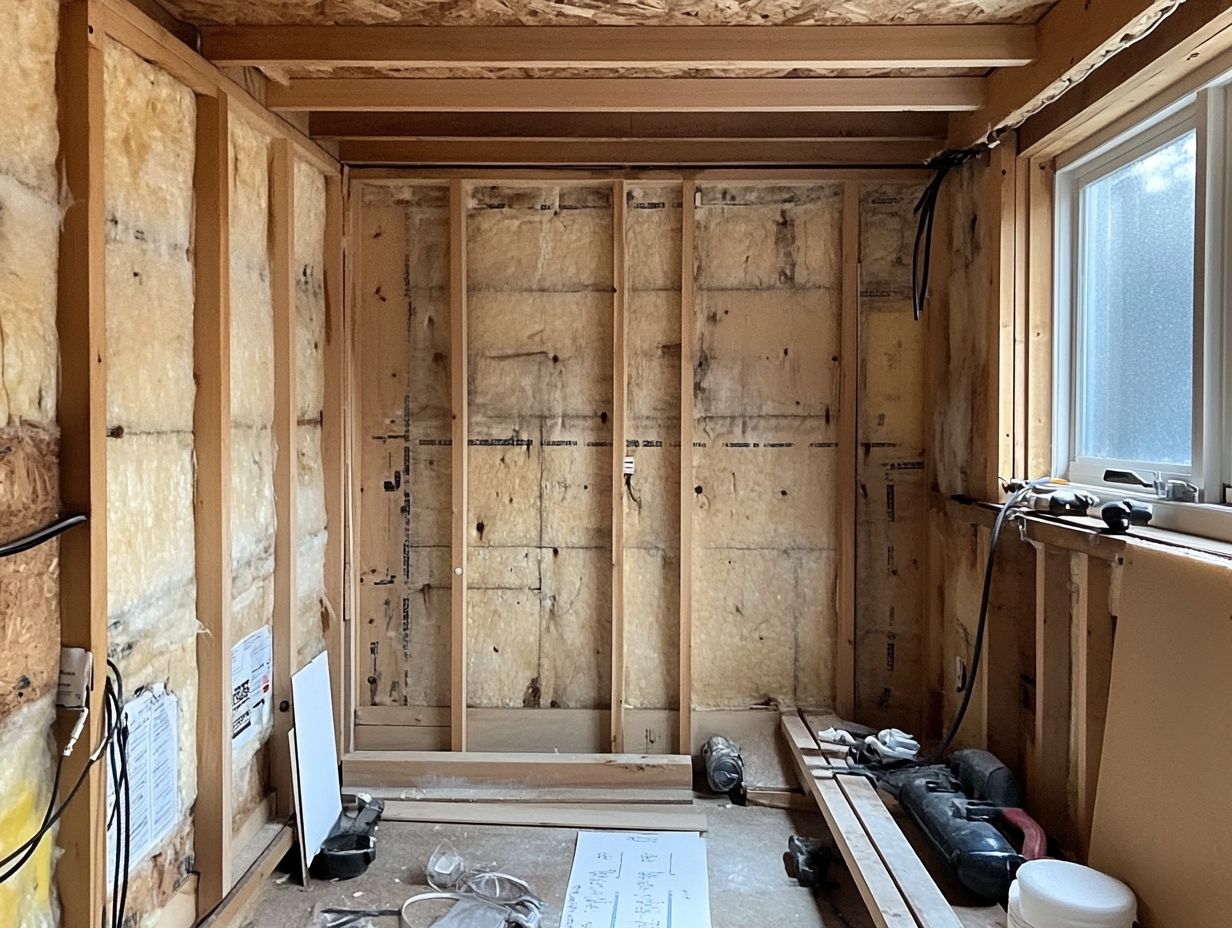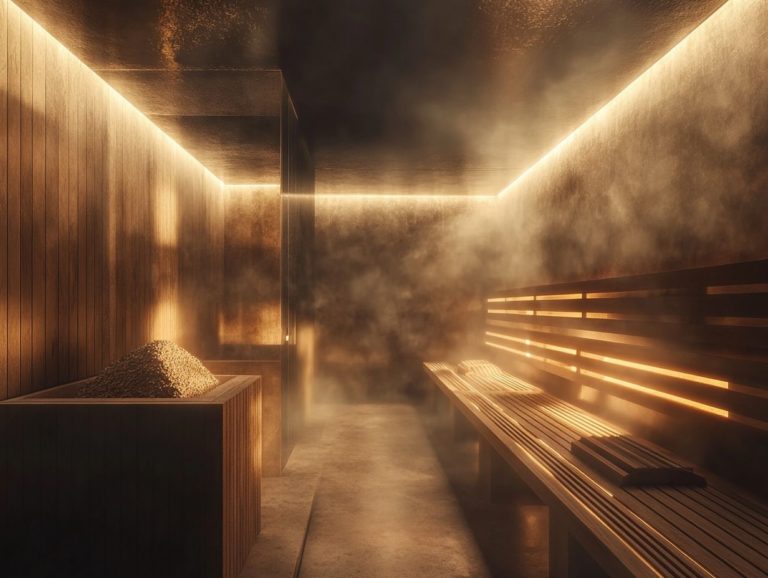Common Mistakes in Sauna Installation
Saunas present a remarkable opportunity for relaxation and health enhancement. However, improper installation can turn your serene retreat into a source of frustration.
Mistakes such as incorrect placement or insufficient ventilation can significantly undermine your sauna experience. This exploration delves into these common pitfalls and offers vital guidance for a successful installation.
Discover how to sidestep these errors and understand how proper installation can elevate your sauna benefits and extend its lifespan.
Continue reading to craft the ideal sanctuary for your well-being.
Contents
- Key Takeaways:
- Common Mistakes in Sauna Installation
- How to Avoid These Mistakes
- Benefits of Proper Sauna Installation
- Frequently Asked Questions
- What should I avoid when installing my sauna?
- How important is proper insulation in sauna installation?
- What Are the Consequences of Inadequate Ventilation in Sauna Installation?
- Why Is Correct Heater Placement Important in Sauna Installation?
- What Are Some Common Mistakes in Material Selection for Sauna Installation?
- Why Is It Important to Follow Manufacturer Instructions in Sauna Installation?
Key Takeaways:

- Proper placement is crucial in sauna installation to ensure safety and maximize performance.
- Insufficient insulation and ventilation can lead to inefficient heating and potential health hazards.
- Following safety guidelines and using the right materials are essential for a successful and long-lasting sauna installation.
What is a Sauna?
A sauna is more than just a small room; it’s your haven for dry or wet heat that promotes relaxation and offers a wealth of wellness benefits. You can choose between indoor and outdoor saunas, each tailored to your preferences and space requirements.
These options provide a distinctive sauna experience that enhances both therapeutic effects and your overall well-being.
Whether it’s tucked into a cozy corner of your home or set amid the tranquility of nature, each sauna type optimizes heat distribution using materials like cedar or pine, creating an inviting ambiance. The heat stimulates your heart rate and boosts circulation, making it an excellent choice for stress relief and detoxification through sweating.
Regular use of a sauna sharpens your mental clarity and brings aesthetic benefits, such as healthier skin. By integrating sauna therapy into your wellness routine, you can transform any space into a serene sanctuary where relaxation and recovery are just a session away making it an essential addition for anyone committed to their health.
Common Mistakes in Sauna Installation
When planning a sauna installation, it’s easy to overlook key details that can lead to common missteps, jeopardizing both the effectiveness and safety of your sauna experience.
From improper placement to insufficient ventilation, recognizing these pitfalls is crucial for creating a functional and secure sauna setup in your personal spa or wellness sanctuary.
Incorrect Placement
One of the most significant challenges in sauna installation is incorrect placement, which greatly impacts both your sauna experience and the overall functionality of the unit. Proper placement considers space requirements and ensures that heat is distributed evenly, aligning seamlessly with your intended wellness design.
Accessibility plays a vital role; your sauna should be conveniently situated near amenities like showers and relaxation areas to enhance comfort. It should blend harmoniously with the existing landscape and architecture, avoiding structural obstacles that could disrupt airflow or heat retention.
When placed incorrectly, you may deal with uneven heating, compromised safety, or even a reluctance to use the sauna altogether. That s why meticulous planning regarding the sauna’s position is essential not only for optimal performance but also to create a rejuvenating and enjoyable experience that aligns with your wellness aspirations.
Transform your space into a serene sanctuary today!
Improper Insulation

Improper insulation is a common oversight in sauna installation. It can undermine both energy efficiency and your overall sauna experience.
Quality insulation is essential for maintaining the desired temperature. It ensures your sauna heater operates effectively without wasting energy.
When your sauna is properly insulated, it retains heat better. This creates a consistent and inviting environment while minimizing strain on the heater.
This enhancement boosts comfort and can lead to significant energy bill savings.
Materials like fiberglass, mineral wool, and foam board are excellent insulation options. Each material has unique properties that elevate performance.
For example, fiberglass offers impressive heat retention and moisture resistance. Mineral wool adds an extra layer of fire protection.
Choosing the right insulation can dramatically affect your sauna’s heating efficiency. It can mean the difference between comfort and frustration.
Inadequate Ventilation
Inadequate ventilation during sauna installation can lead to poor air quality and uncomfortable heat levels. This undermines the very benefits you’re seeking.
Proper ventilation guarantees a consistent flow of fresh air. This is essential for a safe and enjoyable sauna experience.
This steady airflow enhances your comfort. It prevents excessive humidity and heat buildup.
Without sufficient ventilation, harmful gases can accumulate. Stale air can leave you feeling lightheaded or uncomfortable, completely negating your relaxation.
Common pitfalls include blocking vents or relying solely on passive airflow. Both can compromise performance.
Adopting best practices means designing intake and exhaust systems that optimize efficiency. This ensures a balanced environment that remains invigorating and safe for everyone involved.
Using the Wrong Materials
Using the wrong materials in your sauna installation can jeopardize both safety and functionality. It s crucial to select appropriate sauna wood and electrical components.
Opting for the right types of sauna wood, such as cedar or hemlock, elevates the sauna’s look. It also impacts heat retention and overall ambiance.
Incorporating high-quality electrical components guarantees optimal performance. This minimizes the risks associated with electrical failures.
Consider how the durability of these materials will affect your maintenance decisions in the future. Making unsuitable choices could lead to increased repair costs and safety hazards.
Ultimately, grasping the long-term implications of your material selection can set the stage for a safe and enjoyable sauna experience.
Not Following Safety Guidelines
Not following safety guidelines during sauna installation is a serious misstep. It can lead to dangerous conditions like electrical malfunctions and fire hazards.
Adhering to established safety protocols is crucial for the safe operation of sauna heater controls and other electrical components.
To minimize risks, ensure that all electrical wiring complies with local codes and regulations. This might mean hiring a licensed electrician to prevent potential dangers.
Positioning the sauna away from flammable materials significantly bolsters fire safety. Proper installation of heater controls is essential; they should be easily accessible yet protected from direct exposure to steam or water.
By following these essential guidelines, you can establish a secure sauna environment that promotes relaxation and wellness. Don’t risk your safety select the best materials and adhere to proper installation practices!
How to Avoid These Mistakes

To sidestep common pitfalls in sauna installation, follow a few best practices and tips that will help you craft your ideal wellness space.
Thoughtful pre-planning, careful selection of materials, and strict adherence to safety guidelines are essential for a successful sauna experience.
Tips for Proper Sauna Installation
Proper sauna installation demands meticulous attention to detail, ensuring a safe and enjoyable experience. Consider key tips such as selecting high-quality sauna materials, ensuring proper insulation, and adhering to safety and performance standards for electrical components.
Choosing materials like cedar or hemlock is essential; these woods endure high temperatures and resist moisture and decay. For insulation, utilize mineral wool or fiberglass to maintain heat efficiently and minimize energy loss.
Don t underestimate the importance of proper ventilation; it s vital for air circulation, helping to regulate humidity levels and enhance comfort. Install vents both at the top and bottom of the sauna for an optimal environment.
Use safety precautions such as ground fault circuit interrupter (GFCI)-protected outlets and ensure clear access pathways to contribute to a secure setup. Seeking professional advice can provide invaluable insights, ensuring that all components are installed correctly and compliant with local regulations, enhancing your overall sauna experience.
Benefits of Proper Sauna Installation
The advantages of a thoughtfully installed home sauna go far beyond functionality; they elevate the entire sauna experience and optimize thermal benefits for you.
A well-designed indoor sauna facilitates relaxation and alleviates stress, blending effortlessly into your wellness environment. This ensures a luxurious personal spa experience that you truly deserve.
Improved Performance and Longevity
Improved performance and longevity stand out as significant advantages of a well-executed sauna installation, reflecting the quality and care you’ve invested. When key components, like the sauna heater and temperature sensors, are installed correctly, they operate at peak efficiency and have a longer lifespan, delivering consistent and effective heating.
This meticulous attention to detail encompasses various elements, including insulation, wall paneling, and ventilation, each playing a vital role in overall efficiency. Regular maintenance practices, such as cleaning the heater and monitoring for wear and tear, can amplify these benefits. Ensuring your sauna remains dry and that moisture levels are properly regulated prevents mold growth and protects electrical components from damage.
By utilizing high-quality sauna materials and adhering to installation guidelines, you can enjoy a sauna that performs exceptionally well and withstands the test of time, creating a serene escape for years to come.
Frequently Asked Questions

What should I avoid when installing my sauna?
Common mistakes in sauna installation include improper insulation, inadequate ventilation, incorrect heater placement, using the wrong sauna materials, and not following manufacturer instructions.
How important is proper insulation in sauna installation?
Proper insulation is crucial in sauna installation as it helps to retain heat and control humidity levels, enhancing the overall sauna experience. Improper insulation can lead to a less effective and uncomfortable sauna experience.
Ensuring proper sauna installation greatly enhances your relaxation and wellness journey.
What Are the Consequences of Inadequate Ventilation in Sauna Installation?
Poor ventilation can cause moisture buildup and mold.
It can also lead to uncomfortable and dangerous heat levels. Ensure proper ventilation for a safe sauna experience!
Why Is Correct Heater Placement Important in Sauna Installation?
Correct heater placement ensures even heat distribution and helps prevent burns.
Follow manufacturer instructions carefully to enhance fire safety.
What Are Some Common Mistakes in Material Selection for Sauna Installation?
Common mistakes include using the wrong type of sauna wood, which is specifically suited for high heat and humidity, or poor-quality insulation.
Choose high-quality, heat-resistant materials to build a safe and durable sauna.
Why Is It Important to Follow Manufacturer Instructions in Sauna Installation?
Manufacturer instructions offer crucial guidelines and safety tips.
Following them ensures your sauna functions properly and safely!






